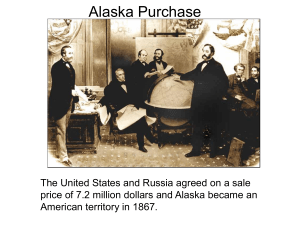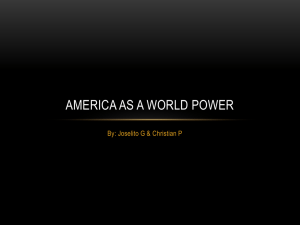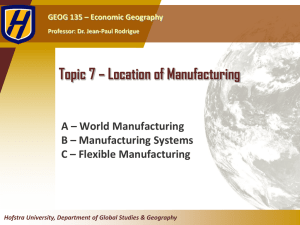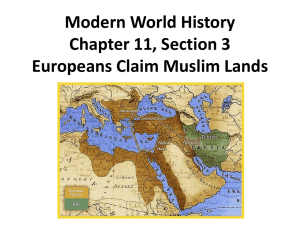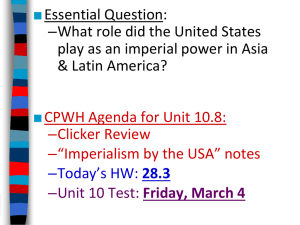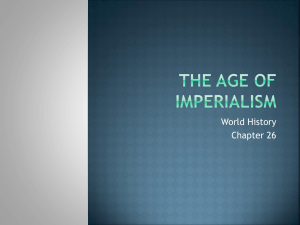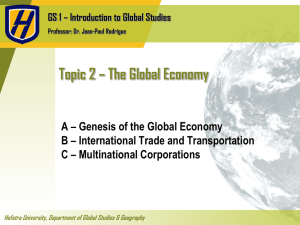Topic 5 - International and Freight Distribution
advertisement
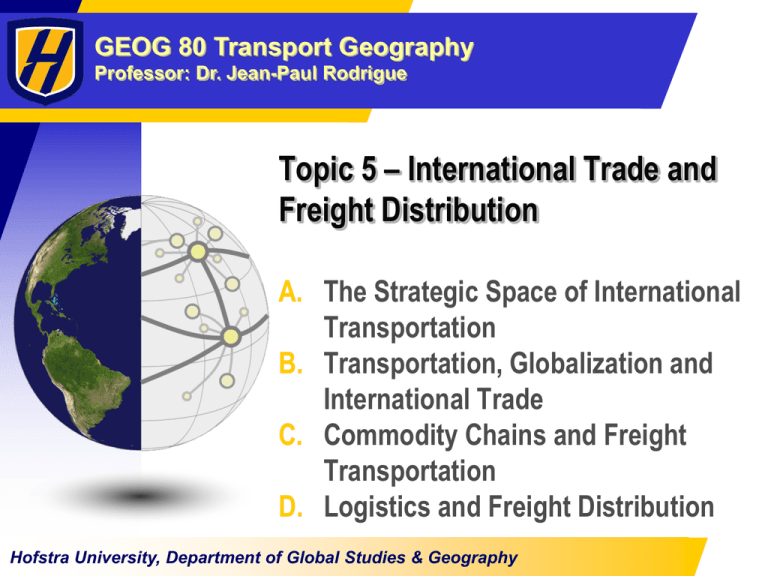
GEOG 80 Transport Geography Professor: Dr. Jean-Paul Rodrigue Topic 5 – International Trade and Freight Distribution A. The Strategic Space of International Transportation B. Transportation, Globalization and International Trade C. Commodity Chains and Freight Transportation D. Logistics and Freight Distribution Hofstra University, Department of Global Studies & Geography A – THE STRATEGIC SPACE OF INTERNATIONAL TRANSPORTATION 1. The Geostrategy of International Transportation 2. The Panama Canal 3. The Suez Canal 4. The Strait of Malacca 5. Other Important Passages © Dr. Jean-Paul Rodrigue 1. The Geostrategy of International Transportation Perspective Issues Conquest Acquire and conquer oceans, territories and resources. Maritime and railroad technology. Competition Mean to compete on the global economy. Prevalent force in shaping modern transportation systems. Right to carry national passengers and freight. Jurisdiction Subject to national rules and regulations. Territorial sea (22 km); complete jurisdiction. Exclusive Economic Zone (340 km); access to resources. Cooperation Common interests favor agreements. Involving access to infrastructures or setting standards (river navigation, rail gauge, trade agreements, transborder transportation). Control Controlling strategic locations. Reduce vulnerability to disruptions. © Dr. Jean-Paul Rodrigue International Boundaries ■ Exclusive economic zone (EEZ): • Third United Nations Convention on the Law of the Sea (1982). • Sea zone over which a state has rights to the exploration and use of marine resources: • Fishing. • Oil and mineral extraction. • 200 nautical miles (370 km) out from its coast. • Cannot prevent free navigation. • Several EEZ are contested: • South China Sea. • Sea formally controlled by Japan but taken by the Soviet Union after WWII. © Dr. Jean-Paul Rodrigue Exclusive Economic Zones: Jurisdiction © Dr. Jean-Paul Rodrigue Maritime Shipping Routes and Strategic Locations: Control © Dr. Jean-Paul Rodrigue Shipping Lanes, Strategic Passages and Oil Reserves in the MiddleLanes, EastStrategic Passages and Oil Reserves in the Middle East Shipping Russia China Bosporus Turkmenistan Turkey Afghanistan Syria Suez Pakistan Iran Iraq India Hormuz Kuwait Libya Egypt QA Saudi Arabia AE Oman Yemen Sudan Bab el-Mandab Millions of barrels per day (2004) Less than 0.5 Oil Reserves (barrels, 2005) Less than 20 billion 20 to 60 billion 0.5 to 2.5 Somalia 2.5 to 5.0 60 to 125 billion More than 125 billion More than 5.0 No significant reserves Dr. Jean-Paul Rodrigue, Dept. of Economics & Geography, Hofstra University, April 2006 © Dr. Jean-Paul Rodrigue Oil Transited at Major Strategic Locations, 2006 Panama Canal & Pileline 0.5 Bosporus 2.4 Bab el-Mandab 3.3 Suez Canal & Sumed Pipeline 4.5 Strait of Malacca 15.0 Strait of Hormuz 16.5 0 2 4 6 8 10 12 14 16 18 Million barrels per day © Dr. Jean-Paul Rodrigue Capacity of Key Strategic Passages Panama Suez Malacca Minimum depth 12 meters (40 feet) 16 meters (58 feet) 21 meters (68 feet) Length 64 km 190 km 800 km Standard Panamax Suez-max Malacca-max Capacity 65,000 dwt 210,000 dwt 300,000 dwt TEU 4,800 12,000 18,000 Transit time 16.5 hours 10 to 12 hours 20 hours © Dr. Jean-Paul Rodrigue 2. The Panama Canal ■ Context • Joins the Atlantic and Pacific oceans at the Isthmus of Panama: • From Cristobal on Limon Bay, an arm of the Caribbean Sea, to Balboa, on the Gulf of Panama. • Ranks as one of the greatest engineering works of all time. • Three main elements: • Gatun Locks (Atlantic side). • Gaillard Cut (continental divide) • Miraflores Locks (Pacific side). • Dimensions: • Slightly more than 64 km long. • Depth of 12.5 meters (39.5 feet), a width of 32 meters (106 feet) and a length of 294 meters (965 feet). • Prevents a 21,000 km detour around South America. • Handles about 12% of the American international seaborne trade. © Dr. Jean-Paul Rodrigue The Panama Canal © Dr. Jean-Paul Rodrigue Panama Canal: Gatun Locks © Dr. Jean-Paul Rodrigue Panama Canal: Gaillard Cut © Dr. Jean-Paul Rodrigue 2. The Panama Canal ■ Early history • Interests: • Began with explorers of Central America the early 16th century: • The Spanish surveyed the Panama region (1534); judged impossible. • American involvement: • Gold discovered in California (1848). • Panama Canal railway constructed (1855). • French attempts: • French Geographical Society of Paris signed a treaty with Columbia (then the owner of the Province of Panama; 1878). • French Canal Company undertook construction (1879-1899). • Project failure: – Financial problems. – Tropical diseases (20,000 workers killed). – Technical difficulties of trying to build a sea level canal. © Dr. Jean-Paul Rodrigue 2. The Panama Canal ■ American intervention • Panama revolt from Columbia (1903), supported by the United States. • Hay-Bunau-Varilla Treaty: • United States guaranteed the independence of Panama. • Perpetual lease on a 16-km (10 miles) strip with complete sovereignty. • Compensation of $10 million and an inflation-indexed annual compensation. ■ Construction • Constructed between 1904 and 1916. • Cost of $387 million (compensation to Panama and $40 million to purchase the previous project from the French Canal Company). • Under the authority of the U.S. Army Corps of Engineers. • 70,000 people worked on the project and about 5,600 died in the process. • Sanitation of the entire canal area (mosquitoes; yellow fever and malaria). © Dr. Jean-Paul Rodrigue 2. The Panama Canal ■ Operations and traffic • Under the jurisdiction of the Panama Canal Authority (1999): • Collect tolls on all ships crossing the canal. • A loaded ship pays about $2.57 per net ton. • The average toll is about $45,000. • Traffic: • • • • 13,000 ships transit the canal every year, (35 ships per day). Grains (43% of the traffic transited). Containers (11%) and petroleum products (10%). Loss of some of its strategic importance due to super-tankers. • Panamax standard: • Equals to 65,000 tons and a draft of 12 meters. © Dr. Jean-Paul Rodrigue 2. The Panama Canal ■ Expansion of the Panama Canal • Capacity limits: • Forced shipping companies to change their routes. • Growing share of “post-panamax” fleet. • Competition: • The Pacific Asia / Suez canal / Mediterranean route. • North American rail landbrige. • Decision reached in 2006 by the Panamanian government. • New set of locks (Atlantic and Pacific sides of the canal): • Depth of 60 feet, a width of 190 feet and a length of 1,400 feet. • Accommodate ships up to 14,000 TEU. • Allow Aframax and Suezmax vessels to pass through the canal. • Will come online by 2014 or 2015. © Dr. Jean-Paul Rodrigue 3. The Suez Canal ■ Context • Running across the Isthmus of Suez in northeastern Egypt. • Connects the Mediterranean Sea with the Gulf of Suez, an arm of the Red Sea. • Dimensions: • Artificial waterway of about 163 km in length. • Width of 60 meters. • No locks, because the Mediterranean Sea and the Gulf of Suez have roughly the same water level. • Ships of 16 meters (58 feet) draft can make the transit. • Capacity: • 150,000 deadweight tons fully loaded. • 25,000 ships per year, but handles about 14,000. © Dr. Jean-Paul Rodrigue 3. The Suez Canal ■ History • • • • First canal excavated about the 13th century BC. Expand trade between the Mediterranean and the Middle East. Restoration efforts were abandoned in the 8th century AD. Colonial expansion of Europe in Asia revitalized the idea of a canal. ■ French construction • • • • French and Egyptians interests (1859-69). Cost of about 100 million dollars. Brought forward a new era of European influence in Pacific Asia. Saving 6,500 km from the circum African route. © Dr. Jean-Paul Rodrigue Geographical Impact of the Suez Canal, 1869 10,000 KM 16,000 KM © Dr. Jean-Paul Rodrigue 3. The Suez Canal ■ British purchase • Britain bought the shares of the Suez Canal Company and became its sole owner (1874). • 1888 agreement: • The canal was open to the vessels of all nations in peace or in war. • Britain claimed the need to control the area to maintain maritime power and colonial interests. • Great Britain acquired the right to maintain defense forces in the Suez Canal (1936). • Strategic importance during World War II to maintain Asia-Europe supply routes for the Allies. © Dr. Jean-Paul Rodrigue Suez Canal, end of 19th Century © Dr. Jean-Paul Rodrigue 3. The Suez Canal ■ Nationalization • Nationalized by Egypt (1956). • Israeli ships were not permitted to cross the canal. • Threat was also extended to France and Britain: • Refused to help finance the Aswan High Dam project. • Israel, France and Britain invaded Egypt (1956). • Egypt sank ships in the canal; closing it between 1956 and 1957. ■ Israel – Arab Wars • Tensions between Israel and Arab nations in the 1960s: • Six Days War Israel and Egypt (1967); Invasion of Sinai by Israel. • Canal Closed (Between 1967 and 1975) • Significantly destabilized international transportation. • Re-opened in 1975 as Egypt agreed to let Israel use the canal. © Dr. Jean-Paul Rodrigue 3. The Suez Canal ■ Modern canal • Widened between 1976 and 1980 to accommodate super-tankers of 150,000 dwt. • Support the oil trade between Europe and the Middle East. • Important with economic growth taking place along Pacific Asia: • Can handle all the existing containerships. • Growing movements of containers along the Suez Canal: • Trade connections with Western Europe. • New connections with the American East Coast. © Dr. Jean-Paul Rodrigue Suez Canal, 1990s © Dr. Jean-Paul Rodrigue Development of the Suez Canal, 1869-2007 Item 1869 1956 1962 1980 1994 1996 2001 2007 Width at 11m Depth (meters) 44 60 90 160 210 210 210 210 Maximum Draft (feet) 22 35 38 53 56 58 62 62 Overall Length (km) 164 175 175 190 190 190 190 190 Doubled Parts (km) none 29 29 78 78 78 78 78 10 14 15.5 19.5 20.5 21 22.5 22.5 5,000 30,000 80,000 150,000 180,000 185,000 210,000 220,000 Water Depth (meters) Maximum Tonnage (dwt) © Dr. Jean-Paul Rodrigue 4. The Strait of Malacca ■ Context • One of most important strategic passage of the World: • Supports the bulk of the maritime trade between Europe and Pacific Asia. • Account for 30% of the world trade. • Main passage between the Pacific and the Indian oceans: • Accounts for 50,000 ships per year (600 per day). • Second passage: The Strait of Sunda (Indonesia). • Outlet to the South China Sea. • Dimensions: • 800 km in length and between 50 and 320 km in width (2.5 km at its narrowest point). • Minimal depth of 70 feet. • Can accommodate ships of about 120,000 tons. © Dr. Jean-Paul Rodrigue The Strait of Malacca © Dr. Jean-Paul Rodrigue 4. The Strait of Malacca ■ History • Important passage point between the Chinese and the Indian worlds. • Controlled at different points in time by Javanese and Malaysian kingdoms. • Arab control: • From the 14th century, the region came under the control of Arab merchants. • Established several fortified trading towns. • Malacca: most important commercial center in Southeast Asia. • European control: • Shifted as the era of European expansion began in the 16th century. • In 1511, Malacca fell to the Portuguese. • Marked the beginning of European control over the Strait. © Dr. Jean-Paul Rodrigue 4. The Strait of Malacca ■ English control • England took control of the passage (1867). • Singapore as a main harbor. • Other important centers such as Malacca and Penang, forming the Strait Settlements. • Control lasted until the Second World War and the independence of Malaysia (1957). • Growing importance of the strait with the growth of trade. • Singapore: • Located at the southern end of the Strait of Malacca. • One of the most important port in the world. • Major oil refining center. © Dr. Jean-Paul Rodrigue The Port of Singapore © Dr. Jean-Paul Rodrigue 5. Other Important Passages ■ The Strait of Hormuz • Strategic link between the oil fields of the Persian gulf and the gulf of Oman (Indian Ocean). • Between 48 and 80 km of width (6 km wide navigation channel). • The most important strategic passage in the world (oil). • Contested by Iran and the United Arab Emirates. ■ Gibraltar • • • • • Peninsula between the Atlantic and the Mediterranean oceans. Obligatory passage point between these two oceans. 64 km long and varies in width from 13 to 39 km. Under British control since its conquest from Spain (1704). Second World War: Gibraltar blocked the access to the Atlantic to the Italian and German fleets of the Mediterranean. © Dr. Jean-Paul Rodrigue 5. Other Important Passages ■ Bosporus • Passage of 30 km in length and of only 1 km in width at its narrowest point. • Only link between the Black Sea and the Mediterranean Ocean. • Passage of growing strategic importance, notably after the fall of the Soviet Union. • The Caspian Sea has vast oil reserves. • A large amount must transit trough the Black Sea and Bosporus to reach external markets. • About 50,000 ships a year, including 5,500 tankers, are transiting through the passage each year. © Dr. Jean-Paul Rodrigue The Dardanelles and Bosporus Passages © Dr. Jean-Paul Rodrigue 5. Other Important Passages ■ The Strait of Magellan Discovered in 1520 by the Portuguese explorer Ferdinand Magellan. Separates South America to Tierra del Fuego. 530 km long and 4 to 24 km of width. Held secret during more than one century to assure the supremacy of Portugal and Spain for the Asian trade of spices and silk. • The Panama Canal (1916) and the North American transcontinental bridge in the 1980s undermined its strategic importance. • • • • ■ The Cape Good Hope • • • • Extreme tip of Africa discovered by the Portuguese (end of the 15th century). Separates the Atlantic and Indian oceans. Vasco de Gamma (1497) and was the first European to reach India by sea. Lost some of its strategic importance with the widening of Suez canal. © Dr. Jean-Paul Rodrigue

